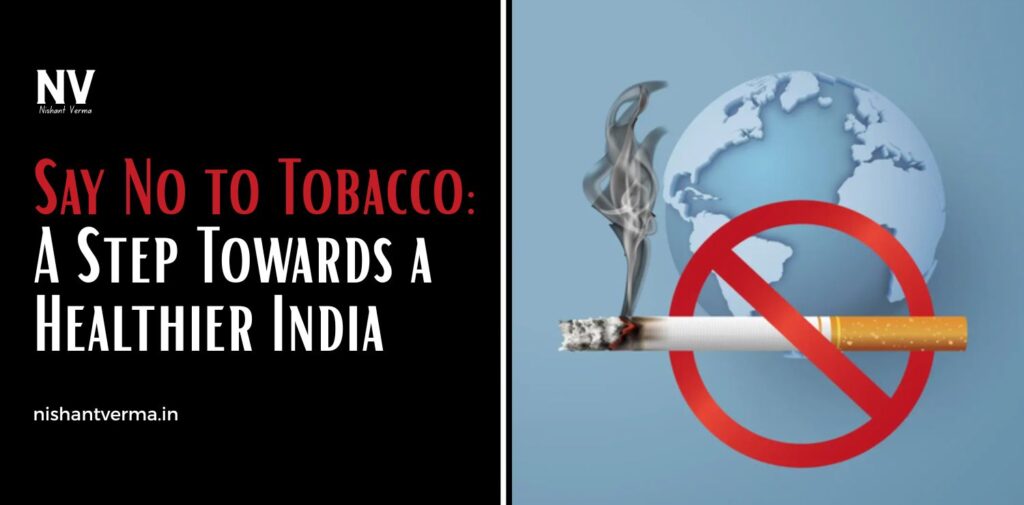Every year, May 31 is observed as World No Tobacco Day, also known in India as Anti-Tobacco Day. This day is dedicated to spreading awareness about the harmful effects of tobacco on health and encouraging people to quit tobacco consumption in any form. The main aim is to reduce tobacco-related deaths and diseases, So Say No to Tobacco and promote a healthy lifestyle.
Tobacco is one of the biggest public health threats in the world. It kills more than 8 million people globally every year, and India contributes significantly to these numbers. Despite knowing the harmful effects, many people in India still consume tobacco in the form of cigarettes, bidis, gutkha, khaini, and other smokeless forms. On this Anti-Tobacco Day, let us understand the reasons behind tobacco addiction, its effects, and most importantly, how we can Say No to Tobacco and help others do the same.
Why People Start Using Tobacco in India
In India, tobacco consumption is not just a personal habit, but also a part of social and cultural behavior in many places. There are several reasons why people start using tobacco:
Peer pressure: Many youngsters start smoking or chewing tobacco just to fit in with their friends or to appear cool and mature.
Lack of awareness: A large number of people, especially in rural areas, are unaware of the serious health risks associated with tobacco.
Stress and depression: People often use tobacco as a way to deal with stress, anxiety, or emotional pain, believing it will give them relief.
Easy availability and low cost: Products like gutkha, khaini, and bidis are cheap and easily available, making them more accessible, especially for low-income groups.
Family influence: In many cases, children and teenagers start using tobacco because they see their parents or elders doing the same.
Media and movies: Tobacco use is often glamorized in movies and media, creating a wrong impression in the minds of young viewers.
Understanding why people start using tobacco is the first step towards helping them quit. If we can control the root causes, we can prevent the spread of tobacco use among future generations.

Harmful Effects of Tobacco on Health
The harmful effects of tobacco on the human body are many and serious. It does not just affect the person who uses it, but also the people around them.
Cancer: Tobacco is the leading cause of cancer in India, especially oral cancer and lung cancer. Smokeless tobacco like gutkha and khaini are directly linked to mouth and throat cancer.
Heart disease: Tobacco damages the blood vessels, raises blood pressure, and increases the risk of heart attacks and strokes.
Respiratory problems: Smoking affects the lungs and causes chronic diseases like bronchitis, asthma, and COPD (Chronic Obstructive Pulmonary Disease).
Poor oral health: Tobacco causes stained teeth, bad breath, gum disease, and in severe cases, loss of teeth and oral cancer.
Reduced immunity: Tobacco weakens the immune system, making it harder for the body to fight off infections and illnesses.
Harm to others: Secondhand smoke is very dangerous, especially for children and pregnant women. It increases the risk of sudden infant death, low birth weight, and respiratory problems in children.
Knowing these effects should be enough to discourage anyone from using tobacco. Yet, the addiction makes it hard for people to quit. That’s why support from family, society, and government is necessary.

How Tobacco Affects the Indian Economy
Apart from health issues, tobacco also has a big impact on the Indian economy.
Healthcare burden: Treating diseases caused by tobacco puts a huge burden on our healthcare system. It costs the government crores of rupees every year.
Loss of productivity: When people fall sick due to tobacco-related diseases, they are unable to work. This results in loss of income and productivity, especially for daily wage earners.
Poverty: Many low-income families spend a large part of their earnings on tobacco products instead of food, education, or healthcare. This pushes them further into poverty.
While the tobacco industry provides jobs and revenue, the long-term damage it causes to the health and economy of the country is far greater. Promoting alternative livelihoods and crops for tobacco farmers can help balance the situation.
Steps Taken by the Indian Government
The Indian government has taken several steps to control tobacco use and create awareness among the people.
COTPA Act: The Cigarettes and Other Tobacco Products Act (COTPA), 2003, bans smoking in public places, prohibits advertisement of tobacco products, and mandates warning labels on tobacco packaging.
Taxation: The government has increased taxes on tobacco products to make them less affordable, especially for the youth.
Awareness campaigns: Various campaigns like the “Tobacco-Free India” initiative and TV advertisements highlight the dangers of tobacco use.
Ban on gutkha: Many states in India have banned the sale of gutkha and other flavored tobacco products.
Tobacco cessation centers: These centers offer free counseling and support to people who want to quit tobacco.
School and college programs: Educational institutions now conduct awareness sessions to discourage students from trying tobacco.
These steps are commendable, but the success of these measures depends largely on the cooperation and awareness of the public.

How You Can Quit Tobacco
Quitting tobacco is not easy, but it is possible with strong willpower, the right support, and a proper plan. Here are some tips to help you or someone you know quit tobacco:
Set a quit date: Choose a date and prepare yourself mentally to stop all forms of tobacco on that day.
Understand your triggers: Identify the situations or emotions that make you crave tobacco and avoid them.
Seek support: Talk to your family, friends, or join a support group. Sharing your journey can make it easier.
Use alternatives: Chew sugar-free gum, drink water, or eat a healthy snack when you feel the urge.
Visit a doctor: A doctor can guide you on nicotine replacement therapy or medications that can reduce withdrawal symptoms.
Reward yourself: Every tobacco-free day is an achievement. Celebrate your progress in healthy ways.
Remember, even if you fail once or twice, do not give up. Many people take several attempts before they finally succeed in quitting.
Role of Youth and Society
The youth of India has the power to bring about real change. If young people take a stand against tobacco, they can influence their peers and family members. Schools, colleges, and social media can play a big role in spreading the message.
Parents and teachers must talk openly to children about the dangers of tobacco. Instead of punishment, children need guidance, motivation, and correct information.
Celebrities and influencers must act responsibly. They should not promote smoking or chewing tobacco, directly or indirectly, in movies, shows, or social media.
Every citizen should report the sale of tobacco near schools or public places. If we all take responsibility, we can create a tobacco-free society.
Conclusion: Say No to Tobacco
Anti-Tobacco Day is not just a one-day event. It is a reminder for all of us to take a pledge for a tobacco-free life. By quitting tobacco, we not only improve our own health but also protect our loved ones and contribute to a healthier India.
India has a long way to go in becoming truly tobacco-free, but the journey starts with small steps. Awareness, support, and strong will can make a big difference.
So this May 31, let’s take a strong stand. Let us say no to tobacco – for ourselves, for our families, and for the future generations of our country.




